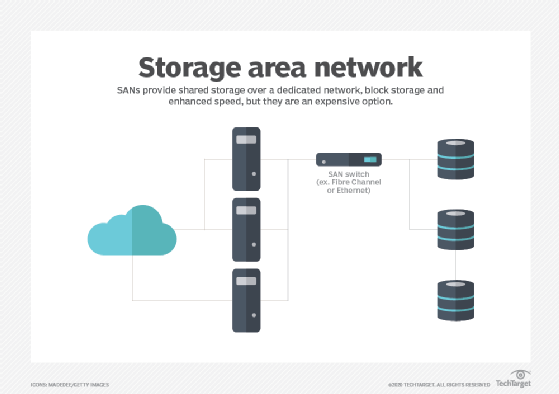Advantages and disadvantages of using a SAN
SAN benefits include speed, scalability and fault tolerance, but the technology isn't without its drawbacks. Cost and complexity are big concerns for smaller organizations.
SANs have become increasingly popular over the years, but they aren't necessarily the right choice for every organization. Before deploying one, organizations should carefully consider storage area network advantages and disadvantages.
Advantages of a storage area network
- Fast
- Easy to scale
- Fault tolerant
- Better hard disk utilization
One of the biggest advantages of using a storage area network is that SANs generally provide better performance than competing technologies, such as NAS. A NAS system acts as a NAS device, with storage traffic being routed across a LAN. These NAS systems are inexpensive -- with some consisting of only a single hard drive -- and easy to configure. However, NAS devices tend to be slow because they are constrained by network bandwidth limitations. Even so, they remain a popular choice -- especially in smaller environments -- for use as file servers or as a general-purpose data storage platform. Some organizations also use NAS devices for data protection.
SANs on the other hand are purpose-built networks designed specifically for storage. Rather than sending storage traffic across a LAN, SAN traffic is usually sent over a Fibre Channel connection. Servers have direct, block-level data access to SAN-based storage devices. The result is better performance than what can typically be achieved through a NAS or similar technology.
SANs are also designed to be easy to scale. An organization can add capacity simply by adding switches and hard disks.

Another advantage to using a SAN is that it helps organizations to use their raw storage more efficiently. Consider that when DAS is used, each server has its own disks, spanned by a file system. Because it's almost impossible to estimate the exact amount of storage space that a server will need, there is almost always some amount of capacity that will go unused. Conversely, SANs treat storage space as a pool of resources that can be allocated on an as-needed basis. This helps avoid wasted capacity.
SANs are specifically designed for use in high-performance, mission-critical environments. As such, they almost always include multiple levels of redundancy. If a switch fails for instance, storage traffic can be automatically rerouted to avoid an outage.
Disadvantages of a storage area network
- Expensive
- Complex
SANs have two main disadvantages. First, SANs are expensive. Redundant, high-performance hardware is costly by its very nature. However, it isn't just the acquisition costs that make SANs expensive. There are also ongoing maintenance and management costs to consider.
The other main disadvantage to operating a SAN is its complexity. Deploying, managing and maintaining a SAN requires special knowledge. As such, organizations that choose to deploy SANs must provide the IT staff with additional training or hire storage administrators.
SAN use cases
Because of their cost and complexity, SANs are best suited for use in large data center environments, especially where scalability, fault tolerance or high performance is required.
Database hosting is one of the most common SAN use cases. Mission-critical applications almost always rely on back-end databases. A SAN can help to ensure that these databases deliver the required level of performance, while also helping to protect the data within the databases.
SANs are also commonly used in virtual server deployments. Server virtualization is based on the idea that physical servers are commonly underutilized and that hardware costs can be decreased by allowing multiple virtual servers to share a physical server's hardware resources. The flip side to this, however, is that VMs compete with one another for access to hardware resources and, if left unchecked, can overwhelm a host. This is especially true for storage IOPS, which tends to be the resource that most often limits the number of VMs that a host can accommodate.
A SAN can help to increase a host's virtual machine density by offloading storage resources from a local storage device. Additionally, a SAN is designed with multiple layers of fault tolerance and can, therefore, help to make VMs more resilient to failure.
Just as SANs can benefit virtual server environments, a storage network can also be beneficial to organizations that host virtual desktops. VDI environments are somewhat like virtual server environments, but they host desktop operating systems such as Windows 10 rather than virtual servers. A VDI platform may host hundreds, or even thousands, of virtual desktops. A SAN can be an ideal storage platform for VDI environments because it can easily scale to accommodate additional virtual desktops as an organization grows.
Reasons not to use a SAN
Even though SANs offer several compelling benefits, there are several important reasons to consider not using a SAN. A SAN is a poor choice if an organization lacks the financial resources to purchase, deploy and maintain it. Even if an organization can afford a SAN, it must consider the effect that a SAN deployment will have on its IT budget. If other costly IT projects take a higher priority, then the SAN deployment might need to wait until next year.
Another reason not to use a SAN is that the organization's IT architecture simply does not justify it. A SAN probably isn't warranted, for instance, if an organization only has a few servers. Likewise, a SAN is unlikely to provide much benefit to an organization if the bulk of its resources are cloud-based or if it relies almost exclusively on hyper-converged systems.
Finally, an organization might choose not to use a SAN is if it lacks the IT staffing resources to properly support it. SANs are complex and supporting and managing a storage network requires a certain amount of expertise. Unless an organization has the necessary expertise, it is probably going to be better off adopting a different storage solution.








